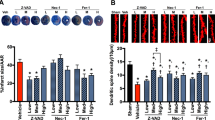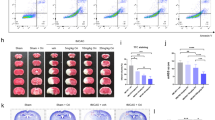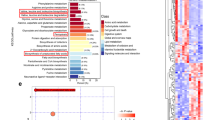Abstract
Transient global ischemia in rats induces delayed death of hippocampal CA1 neurons. Early events include caspase activation, cleavage of anti-death Bcl-2 family proteins and large mitochondrial channel activity. However, whether these events have a causal role in ischemia-induced neuronal death is unclear. We found that the Bcl-2 and Bcl-xL inhibitor ABT-737, which enhances death of tumor cells, protected rats against neuronal death in a clinically relevant model of brain ischemia. Bcl-xL is prominently expressed in adult neurons and can be cleaved by caspases to generate a pro-death fragment, ΔN-Bcl-xL. We found that ABT-737 administered before or after ischemia inhibited ΔN-Bcl-xL–induced mitochondrial channel activity and neuronal death. To establish a causal role for ΔN-Bcl-xL, we generated knock-in mice expressing a caspase-resistant form of Bcl-xL. The knock-in mice exhibited markedly reduced mitochondrial channel activity and reduced vulnerability to ischemia-induced neuronal death. These findings suggest that truncated Bcl-xL could be a potentially important therapeutic target in ischemic brain injury.
This is a preview of subscription content, access via your institution
Access options
Subscribe to this journal
Receive 12 print issues and online access
$209.00 per year
only $17.42 per issue
Buy this article
- Purchase on Springer Link
- Instant access to full article PDF
Prices may be subject to local taxes which are calculated during checkout







Similar content being viewed by others
References
Moskowitz, M.A., Lo, E.H. & Iadecola, C. The science of stroke: mechanisms in search of treatments. Neuron 67, 181–198 (2010).
Zukin, R.S. et al. Molecular and cellular mechanisms of ischemia-induced neuronal death. in Stroke: Pathophysiology, Diagnosis and Management (eds. Mohr, J.P., Choi, D.W., Grotta, J.C., Weir, B. & Wolf, P.A.) 829–854 (Churchill Livingstone Elsevier, Philadelphia, 2004).
Liou, A.K., Clark, R.S., Henshall, D.C., Yin, X.M. & Chen, J. To die or not to die for neurons in ischemia, traumatic brain injury and epilepsy: a review on the stress-activated signaling pathways and apoptotic pathways. Prog. Neurobiol. 69, 103–142 (2003).
Sugawara, T., Fujimura, M., Morita-Fujimura, Y., Kawase, M. & Chan, P.H. Mitochondrial release of cytochrome c corresponds to the selective vulnerability of hippocampal CA1 neurons in rats after transient global cerebral ischemia. J. Neurosci. 19, RC39 (1999).
Tanaka, H. et al. Ischemic preconditioning: neuronal survival in the face of caspase-3 activation. J. Neurosci. 24, 2750–2759 (2004).
Miyawaki, T. et al. Ischemic preconditioning blocks BAD translocation, Bcl-xL cleavage, and large channel activity in mitochondria of postischemic hippocampal neurons. Proc. Natl. Acad. Sci. USA 105, 4892–4897 (2008).
Yuan, J. Neuroprotective strategies targeting apoptotic and necrotic cell death for stroke. Apoptosis 14, 469–477 (2009).
Youle, R.J. & Strasser, A. The BCL-2 protein family: opposing activities that mediate cell death. Nat. Rev. Mol. Cell Biol. 9, 47–59 (2008).
Galonek, H.L. & Hardwick, J.M. Upgrading the BCL-2 network. Nat. Cell Biol. [comment] 8, 1317–1319 (2006).
Oltersdorf, T. et al. An inhibitor of Bcl-2 family proteins induces regression of solid tumors. Nature 435, 677–681 (2005).
Richardson, A. & Kaye, S.B. Pharmacological inhibition of the Bcl-2 family of apoptosis regulators as cancer therapy. Curr. Mol. Pharmacol. 1, 244–254 (2008).
Cragg, M.S., Harris, C., Strasser, A. & Scott, C.L. Unleashing the power of inhibitors of oncogenic kinases through BH3 mimetics. Nat. Rev. Cancer 9, 321–326 (2009).
Vogler, M. et al. Concurrent up-regulation of BCL-XL and BCL2A1 induces approximately 1,000-fold resistance to ABT-737 in chronic lymphocytic leukemia. Blood 113, 4403–4413 (2009).
Jonas, E.A. et al. Modulation of synaptic transmission by the BCL-2 family protein BCL-xL . J. Neurosci. 23, 8423–8431 (2003).
Hickman, J.A., Hardwick, J.M., Kaczmarek, L.K. & Jonas, E.A. Bcl-xL inhibitor ABT-737 reveals a dual role for Bcl-xL in synaptic transmission. J. Neurophysiol. 99, 1515–1522 (2008).
Li, Z. et al. Caspase-3 activation via mitochondria is required for long-term depression and AMPA receptor internalization. Cell 141, 859–871 (2010).
Clem, R.J. et al. Modulation of cell death by Bcl-xL through caspase interaction. Proc. Natl. Acad. Sci. USA 95, 554–559 (1998).
Cheng, E.H. et al. Conversion of Bcl-2 to a Bax-like death effector by caspases. Science 278, 1966–1968 (1997).
Li, H., Zhu, H., Xu, C.J. & Yuan, J. Cleavage of BID by caspase 8 mediates the mitochondrial damage in the Fas pathway of apoptosis. Cell 94, 491–501 (1998).
Luo, X., Budihardjo, I., Zou, H., Slaughter, C. & Wang, X. Bid, a Bcl2 interacting protein, mediates cytochrome c release from mitochondria in response to activation of cell surface death receptors. Cell 94, 481–490 (1998).
Bonanni, L. et al. Zinc-dependent multi-conductance channel activity in mitochondria isolated from ischemic brain. J. Neurosci. 26, 6851–6862 (2006).
Calderone, A. et al. Ischemic insults derepress the gene silencer REST in neurons destined to die. J. Neurosci. 23, 2112–2121 (2003).
Krajewska, M. et al. Dynamics of expression of apoptosis-regulatory proteins Bid, Bcl-2, Bcl-X, Bax and Bak during development of murine nervous system. Cell Death Differ. 9, 145–157 (2002).
Chen, J. et al. Induction of caspase-3–like protease may mediate delayed neuronal death in the hippocampus after transient cerebral ischemia. J. Neurosci. 18, 4914–4928 (1998).
Jover, T. et al. Estrogen protects against global ischemia-induced neuronal death and prevents activation of apoptotic signaling cascades in the hippocampal CA1. J. Neurosci. 22, 2115–2124 (2002).
Colbourne, F., Sutherland, G.R. & Auer, R.N. Electron microscopic evidence against apoptosis as the mechanism of neuronal death in global ischemia. J. Neurosci. 19, 4200–4210 (1999).
Fujita, N., Nagahashi, A., Nagashima, K., Rokudai, S. & Tsuruo, T. Acceleration of apoptotic cell death after the cleavage of Bcl-xL protein by caspase-3-like proteases. Oncogene 17, 1295–1304 (1998).
Dejean, L.M. et al. Oligomeric Bax is a component of the putative cytochrome c release channel MAC, mitochondrial apoptosis-induced channel. Mol. Biol. Cell 16, 2424–2432 (2005).
Hetz, C. et al. Bax channel inhibitors prevent mitochondrion-mediated apoptosis and protect neurons in a model of global brain ischemia. J. Biol. Chem. 280, 42960–42970 (2005).
van Delft, M.F. et al. The BH3 mimetic ABT-737 targets selective Bcl-2 proteins and efficiently induces apoptosis via Bak/Bax if Mcl-1 is neutralized. Cancer Cell [see comment] 10, 389–399 (2006).
Kirsch, D.G. et al. Caspase-3-dependent cleavage of Bcl-2 promotes release of cytochrome c. J. Biol. Chem. 274, 21155–21161 (1999).
Basañez, G. et al. Pro-apoptotic cleavage products of Bcl-xL form cytochrome c–conducting pores in pure lipid membranes. J. Biol. Chem. 276, 31083–31091 (2001).
Graham, S.H. & Chen, J. Programmed cell death in cerebral ischemia. J. Cereb. Blood Flow Metab. 21, 99–109 (2001).
Okuno, S., Saito, A., Hayashi, T. & Chan, P.H. The c-Jun N-terminal protein kinase signaling pathway mediates Bax activation and subsequent neuronal apoptosis through interaction with Bim after transient focal cerebral ischemia. J. Neurosci. 24, 7879–7887 (2004).
Hochhauser, E. et al. Bax ablation protects against myocardial ischemia-reperfusion injury in transgenic mice. Am. J. Physiol. Heart Circ. Physiol. 284, H2351–H2359 (2003).
Wang, X. et al. Developmental shift of cyclophilin D contribution to hypoxic-ischemic brain injury. J. Neurosci. 29, 2588–2596 (2009).
Lewis, J. et al. Inhibition of virus-induced neuronal apoptosis by Bax. Nat. Med. 5, 832–835 (1999).
Fannjiang, Y. et al. BAK alters neuronal excitability and can switch from anti- to pro-death function during postnatal development. Dev. Cell 4, 575–585 (2003).
Nakagawa, T. & Yuan, J. Cross-talk between two cysteine protease families. Activation of caspase-12 by calpain in apoptosis. J. Cell Biol. 150, 887–894 (2000).
Hara, H. et al. Attenuation of transient focal cerebral ischemic injury in transgenic mice expressing a mutant ICE inhibitory protein. J. Cereb. Blood Flow Metab. 17, 370–375 (1997).
Cao, G. et al. Cloning and characterization of rat caspase-9: implications for a role in mediating caspase-3 activation and hippocampal cell death after transient cerebral ischemia. J. Cereb. Blood Flow Metab. 22, 534–546 (2002).
Ofengeim, D., Miyawaki, T. & Zukin, R.S. Molecular and cellular mechanisms of ischemia-induced neuronal death. in Stroke: Pathophysiology, Diagnosis and Management (eds. Mohr, J.P., Choi, D.W., Grotta, J.C., Weir, B. & Wolf, P.A.) 1–39 (Churchill Livingstone Elsevier, Philadelphia, 2011).
Northington, F.J., Chavez-Valdez, R. & Martin, L.J. Neuronal cell death in neonatal hypoxia-ischemia. Ann. Neurol. 69, 743–758 (2011).
Alavian, K.N. et al. Bcl-xL regulates metabolic efficiency of neurons through interaction with the mitochondrial F(1)F(O) ATP synthase. Nat. Cell Biol. 13, 1224–1233 (2011).
Chen, Y.B. et al. Bcl-xL regulates mitochondrial energetics by stabilizing the inner membrane potential. J. Cell Biol. 195, 263–276 (2011).
Miyawaki, T. et al. The endogenous inhibitor of Akt, CTMP, is critical to ischemia-induced neuronal death. Nat. Neurosci. 12, 618–626 (2009).
Brown, M.R., Sullivan, P.G. & Geddes, J.W. Synaptic mitochondria are more susceptible to Ca2+ overload than nonsynaptic mitochondria. J. Biol. Chem. 281, 11658–11668 (2006).
Sims, N.R. & Anderson, M.F. Isolation of mitochondria from rat brain using Percoll density gradient centrifugation. Nat. Protoc. 3, 1228–1239 (2008).
Wei, M.C. et al. Proapoptotic BAX and BAK: a requisite gateway to mitochondrial dysfunction and death. Science [see comment] 292, 727–730 (2001).
Formisano, L. et al. Ischemic insults promote epigenetic reprogramming of mu opioid receptor expression in hippocampal neurons. Proc. Natl. Acad. Sci. USA 104, 4170–4175 (2007).
Acknowledgements
We thank A. Latuszek-Barrantes for excellent technical assistance, and J. Hickman, R. Kitsis and L.K. Kaczmarek for insightful scientific discussion and constructive review of the manuscript. We thank C. Kinnally and N. Danial for the gift of Bax−/−; Bak−/− MEFs and the Institut de Recherches Servier for ABT-737. This work was supported by grants from the US National Institutes of Health (NS045876 to E.A.J., NS46742 to R.S.Z. and NS37402 to J.M.H.), a McKnight Foundation Brain Disorders Award (to R.S.Z.) and a generous grant from the F.M. Kirby Foundation (to R.S.Z.). R.S.Z. is the F.M. Kirby Professor of Neural Repair and Protection.
Author information
Authors and Affiliations
Contributions
D.O. performed the experiments, wrote and prepared the manuscript, and made intellectual contributions to the study. Y.-b.C. created the knock-in mouse. T.M., H.L., S.S., R.J.F. and F.P. performed experiments. K.N.A. performed experiments and made intellectual contributions. B.A.R. assisted with knock-in mouse colony preparation. J.A.H. provided intellectual contributions. J.M.H. and R.S.Z. designed experiments, wrote the manuscript and provided intellectual contributions. E.A.J. designed experiments, performed experiments, wrote the manuscript and provided intellectual contributions.
Corresponding authors
Ethics declarations
Competing interests
The authors declare no competing financial interests.
Supplementary information
Supplementary Text and Figures
Supplementary Figures 1–11 (PDF 1129 kb)
Rights and permissions
About this article
Cite this article
Ofengeim, D., Chen, Yb., Miyawaki, T. et al. N-terminally cleaved Bcl-xL mediates ischemia-induced neuronal death. Nat Neurosci 15, 574–580 (2012). https://doi.org/10.1038/nn.3054
Received:
Accepted:
Published:
Issue Date:
DOI: https://doi.org/10.1038/nn.3054
This article is cited by
-
Neuroprotective effects of ATPase inhibitory factor 1 preventing mitochondrial dysfunction in Parkinson's disease
Scientific Reports (2022)
-
Murine glial progenitor cells transplantation and synthetic PreImplantation Factor (sPIF) reduces inflammation and early motor impairment in ALS mice
Scientific Reports (2022)
-
Inhibition of Bcl-xL prevents pro-death actions of ΔN-Bcl-xL at the mitochondrial inner membrane during glutamate excitotoxicity
Cell Death & Differentiation (2017)
-
Reactive astrocytes function as phagocytes after brain ischemia via ABCA1-mediated pathway
Nature Communications (2017)
-
Mimicking Cdk2 phosphorylation of Bcl-xL at Ser73 results in caspase activation and Bcl-xL cleavage
Cell Death Discovery (2016)



